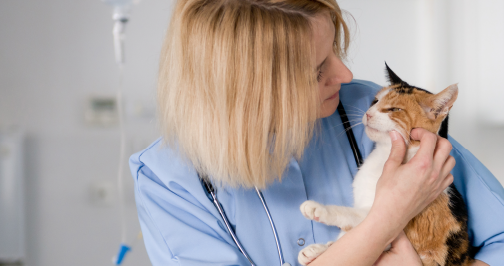TRENDS IN YOUR INBOX: Where Are All the Cats? 5 Barriers of Feline Preventive Care and How to Overcome Them


“We need a paradigm shift that the cat comes to see the veterinarian for a thorough exam, and only then it will be determined what that cat needs.”
—Renee Rucinsky, DVM, DABVP (F)
If getting cats in the door of your veterinary hospital is like, well, herding cats, you’re not alone.
Statistics from the Bayer Veterinary Care Usage Study III: Feline Findings, conducted in collaboration with the American Association of Feline Practitioners (AAFP) in 2012, showed that only half as many cats receive annual exams as dogs—and most new feline patients who do visit the veterinarian don’t return.
But why? Like everything about our finicky felines, it’s complicated, but a cause worthy of exploration. In this article, we’ll take a look at the most common beliefs, biases, and blocks keeping cats out of your practice and what you can do to draw them back in.
Barrier #1: The Initial Visit
According to Sara Fleissner Nunn, practice development director at AAHA-accredited Frontier Veterinary Hospital in Hillsboro, Oregon, the greatest hurdle to overcome with cat owners is gaining the opportunity to have the conversation in the first place.
“The most difficult thing is getting clients to bring their cat[s] in for the first preventive care visit,” she said. “Getting them to make that first appointment is key; that first point of contact allows you to educate and set follow-up communication in place to ensure that cat returns.”

“There are many practices that are dog centric—some unconsciously and some [that] have doctors and staff that quietly dislike treating cats. Look at your marketing and social media. Are cats equally represented? Look at your staff. Do they have cats themselves? Look at your treatment room. Do you have a doctor or technician who won’t handle cats or complains about it if they do?”
—Sara Fleissner Nunn
While many veterinary professionals balk at the idea of discounting valuable services, Nunn said practices must be willing to focus marketing efforts—and dollars—on getting cat owners in the door.
Identifying feline patients as an opportunity to reverse the hospital’s declining visits in the aftermath of the economic recession, Frontier began promoting Cat Month in July 2009 with half off all feline exams—and saw a record number of cats in one of the few highly successful months of that year as a result.
While the promotion itself has seen many iterations over the years—from the original discounted exam to an additional discount on a comprehensive preventive care package that includes vaccines, parasite screening, and diagnostic testing—Nunn said the positive results have been consistent, citing an increase each year in both feline visits and the specific promotion over the previous year.
“Our philosophy is that discounts can work if they are specific, time bound, diligently monitored, and evolve with changing economic conditions and client needs,” she said. “We’ve successfully gone from using an inexpensive exam to get cats in to clients opting for a complete preventive care package for their cats in under 10 years.”
Barrier #2: Client Communication
Communication can make or break a preventive care visit. What you say and how you say it plays a critical role in ensuring your clients receive and retain your recommendations—and return for necessary visits in the future.
Renee Rucinsky, DVM, DABVP (F), owner of AAHA-accredited Mid Atlantic Cat Hospital in Queenstown, Maryland, said longtime clients of the feline-only practice are accustomed to discussions about preventive care, but educating new clients takes time.
“The learning curve for them can be steep, and breaking those old-fashioned habits is the hardest thing to overcome,” she said. “Hearing that we recommend exams every six months, that we recommend screening bloodwork annually starting at three years old, that we recommend heartworm prevention, these are all things that may never have been discussed with them before.”
With so much ground to cover, it can be easy for clients to become overwhelmed and tune out. Instead of going into a rushed, information-overloaded sales pitch, Rucinsky recommends scheduling ample time to review the importance of your preventive care recommendations—a typical appointment at her practice lasts between 30 and 45 minutes. She also recommends leveraging other members of the practice team to provide courteous, consistent, and concise preventive care reminders at each touchpoint.

“Clients don’t see their cats as second-class citizens to dogs anymore. They are important family members.”
—Renee Rucinsky, DVM, DABVP (F)
“Find a staff member or two who really like this aspect of veterinary care, and give them the freedom to drive this part of the practice,” she said. “Doctors can come up with the protocols, but let your staff do what they are trained to do.”
Most importantly, she said, preventive care should always be treated as a discussion, not a checklist.
“We need a paradigm shift that the cat comes to see the veterinarian for a thorough exam, and only then it will be determined what that cat needs,” she said. “Vaccines may be included, but so might strategic deworming, lab testing, behavioral and nutritional counseling, and whatever else. The days of just coming in for annual vaccines need to be over, and we need to stress that we are here for the total health of the cat for the entire life of the cat.”
Barrier #3: Cat (Un)friendly Practices
Spritzing some feline pheromones in your exam rooms and calling yourself cat friendly? Not so fast.
Established by the AAFP and the International Society of Feline Medicine, the Cat Friendly Practice program was created in 2012 to equip practices with the tools and resources to deliver elevated care for cats and reduce the stress associated with feline veterinary visits. But it isn’t about just checking the boxes, said Paula Monroe-Aldridge, DVM, current AAFP president and associate veterinarian at River Trail Animal Hospital and Pet Lodge in Tulsa, Oklahoma.
“The Cat Friendly Practice program is more than a designation that proves the practice meets certain criteria,” she said. “It’s about ensuring the best experience for the client and feline patient, having the entire veterinary team working together, and knowing how to treat cats in a manner that is respectful for the cat, including communicating with the cat caregiver, and much more.”
This includes regularly evaluating how your practice supports feline patients and how your team’s beliefs and biases can affect the care you provide, said Fleissner Nunn, a self-described cat advocate and member of the AAFP’s Cat Friendly Practice Task Force.
“This question may unearth uncomfortable realities about your practice’s attitude toward cats,” she said. “There are many practices that are dog centric—some unconsciously and some [that] have doctors and staff that quietly dislike treating cats. Look at your marketing and social media. Are cats equally represented? Look at your staff. Do they have cats themselves? Look at your treatment room. Do you have a doctor or technician who won’t handle cats or complains about it if they do?”
If you can easily identify these gaps in your practice, resources provided by the AAFP—including feline behavior training, low-stress handling techniques, and tips for making your facility more cat friendly—can help.
In addition, the AAFP recommends identifying the cat lovers in your practice to act as advocates for their care. “It’s a great grassroots way of getting your whole staff’s buy-in toward working together to improve cat care and owner compliance,” Nunn said.

“The bottom line is that cat owners love their cats and want to do the best for them. We, as veterinarians, need to educate them as to what that entails.”
—Paula Monroe-Aldridge, DVM
Barrier #4: Small-Dog Medicine
Just as cats are not small dogs, cat owners are not small-dog owners.
While it is crucial for veterinary professionals to learn and understand cats’ unique behaviors and preferences, it’s equally important to pay attention to what cat owners want and cater to their needs.
“We need to try to view the experience from both the cat and cat owner’s perspectives,” Monroe-Aldridge said. “If the client has a better experience, they will form a bond, and they will be back. You then become a trustworthy source and can provide education that is more easily heard and retained.”
For Ellen Carozza, LVT, head technician at AAHA-accredited Nova Cat Clinic in Arlington, Virginia, this means having an open and honest discussion to break down treatment roadblocks and ensure continuity of care at home.
“You have to pep talk and train them to be confident in being able to care for their cat,” she said. “Speaking to them in a level they understand—not medical jargon—and getting a bit personal really does make them open up and be honest with their concerns, which allows us to individualize each care plan.”
It is also important to ensure your practice is offering products that meet feline patients’ needs.
“Carrying preventive products that do more in one application can help,” Carozza said. “When it comes to vaccines, carrying the ones with no adjuvant will increase compliance for yearly vaccines. Once [clients] hear the [phrase] ‘vaccine-induced fibrosarcoma’—either from a friend, the internet, or you—it can be game over. Reassurance that only the highest-quality products are used on the cats to prevent these issues creates more compliance.”
Barrier #5: Bad Cat-itudes
As the saying goes, old habits die hard.
According to Jane Brunt, DVM, executive director of The CATalyst Council and owner of AAHA-accredited Cat Hospital at Towson in Baltimore, Maryland, common misperceptions among cat owners about what cats need—as well as the value proposition of getting care when they think they need it—are still among the most significant pain points of feline healthcare.

Thanks to the work of the AAFP, The CATalyst Council, and other veterinary organizations, however, these outdated beliefs finally seem to be shifting, and veterinary practices should be ready to strike while the iron is hot.
“Owners are definitely more in tune with preventive care, and, at least with our long-term clients, I truly believe it’s a result of all of our hard work over the years educating them,” Rucinsky said. “Clients don’t see their cats as second-class citizens to dogs anymore. They are important family members. Most of the cats will have longer lifespans than the dogs in the family, and, as veterinarians, we need to make sure that we take advantage of clients wanting quality care.”
At Frontier, Fleissner Nunn said there has been a noticeable shift in perception since the hospital began its cat-friendly efforts and compliance tracking—and as cats have evolved from independent, outdoor pets to indoor companions.
“Now that cats aren’t getting hit by cars or falling victim to wildlife as much, cat owners have come to realize that their cats can live a very long time,” she said. “As these cat owners have absorbed our education about the real benefits of preventive care in cats, especially when it comes to early detection and managing chronic conditions, they are more likely to choose to do diagnostic testing preventively. I’ve heard many clients remark that they lost a past cat to kidney disease [or] diabetes, and they don’t want that to happen again now that they know these conditions can be caught and treated.”
Of course, Nunn said, not all cat owners are there yet, and that’s OK.
“There are different types of cat owners,” she said. “You need to identify the subcategories that exist in your practice, and meet them where they are by giving them what they want.”
For Frontier, Fleissner Nunn said there are two main categories—the bonded “cat parents” and the “cat owners,” who view their cats as secondary or low-maintenance pets—and the hospital offers preventive care packages to meet both of their needs.
Despite these differences, Monroe-Aldridge said, cat owners are all the same in one important respect.
“The bottom line is that cat owners love their cats and want to do the best for them,” she said. “We, as veterinarians, need to educate them as to what that entails.”



